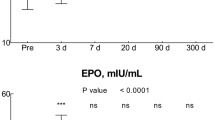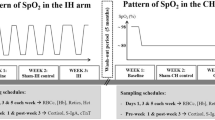Abstract
The aim of this study was first to investigate cardio-ventilatory and haematological responses induced by intermittent acclimation and second to study de-adaptation from high altitude observed after descent. To achieve these objectives nine subjects were submitted to intermittent acclimation in a low barometric chamber (8 h daily for 5 days, day 1 at 4500 m, day 5 at 8500 m) before an expedition to the Himalayas. Cardio-ventilatory changes were measured during a hypobaric poikilocapnic hypoxic test (4500 m, barometric pressure = 589 hPa) and haematological changes were studied at sea level. These measurements were performed before and after acclimation, after return to sea level, but also 1 and 2 months after the expedition. In addition, partial pressures of oxygen and carbon dioxide in arterial blood (P aO2, P aCO2) and arterial erythropoietin concentration [EPO] were measured at rest during the hypoxic test. Results suggested the pre-adaptation protocol was efficient since an increased P aO2 (+12%, P < 0.05), a smaller difference in alveolo-arterial P02 ( −63%, P < 0.05) and a lower P aCO2 ( −11%, P < 0.05), subsequent to ventilatory changes, were observed after acclimation with a significant increase in reticulocytes and in sea level [EPO] (+44% and +62% respectively, P < 0.05). Deadaptation was characterized by a loss of these cardioventilatory changes 1 month after descent, whereas the haematological changes (increased red blood cells and packed cell volume, P < 0.05) persisted for 1 month before disappearing 2 months after descent. This study would also suggest that acute hypoxia performed after a sojourn at high altitude could induce significantly depressed EPO responses (P < 0.05).
Similar content being viewed by others
References
Cerretelli P, Ferretti G (1990) Muscular exercise at high altitude. Int J Sports Med 11l:S1-S34
Eckardt KU, Boutellier U, Kurtz A, Schopen M, Koller EA, Bauer C (1989) Rate of erythropoietin formation in humans in responses to acute hypobaric hypoxia. J Appl Physiol 66:1785–1788
Heath D, Williams DR (1981) Man at high altitude, 2nd edn. Churchill Livingstone, Edinburgh, p 56
Jelkmann W (1992) Erythropoietin: structure, control of production, and function. Physiol Rev 72:449–489
Kayser B (1992) Nutrition and high altitude exposure. Int J Sports Med 13:S129–132
Kayser B (1994) Nutrition and energetics of exercise at altitude. Theory and possible practical implications. Sports Med 17:309–323
Knaupp W, Khilnani S, Sherwood J, Scharf S, Steinberg H (1992) Erythropoietin response to acute normobaric hypoxia in humans. J Appl Physiol 73:837–840
Lohman TG, Boileau RA, Massey BH (1975) Prediction of lean body mass in young boys from skinfold thickness and body weight. Hum Biol 47:245–262
Maïrbaurl H (1994) Red blood cell function in hypoxia at altitude and exercise. Int J Sports Med 15:51–63
Matsuyama S, Kimura H, Sugita T, Kuriyama T, Tatsumi K, Kunitomo F, Okita S, Tojima H, Yuguchi Y, Watanabe S, Honda Y (1986) Control of ventilation in extreme-altitude climbers. J Appl Physiol 61:500–506
Milledge JS, Cotes PM (1985) Serum erythropoïetin in humans at high altitude and its relation to plasma renin. J Appl Physiol 59:360–364
Nagasaka T, Satake T (1969) Changes of pulmonary and cardiovascular functions in subjects confined intermittently in a low pressure chamber for 3 consecutive days. Fed Proc 28: 1312–1315
Oelz O, Regard M, Wichmann W, Valavanis A, Witztum A, Brugger P, Cerretelli P, Landis T (1990) Cognitive impairment. Neurologic performance and MRI after repeat exposure to extreme altitude. In: Sutton JR, Coates G, Remmers JE (eds) Hypoxia: the adaptations. Decker, Toronto, pp 206–209
Richalet JP, Bittel J, Herry JP, Janin C, Savourey G, Le Trong JL, Auvert JF (1992) Pre-acclimatization to high altitude in a hypobaric chamber: Everest Turbo, In: Sutton JR, Coates G, Houston CS (eds) Hypoxia and mountain medicine. Pergamon Press, New York, pp 202–212
Savourey G, Garcia N, Besnard Y, Hanniquet AM, Fine MO, Bittel J (1994) Physiological changes induced by pre-adaptation to high altitude. Ear J Appl Physiol 69:221–227
Savourey G, Moirant C, Eterradossi J, Bittel J (1995) Acute mountain sickness relates to sea-level partial pressure of oxygen. Eur J Appl Physiol 70:469–476
West JB, Lahiru S, Maret KM, Peters RM, Pizzo CJ (1983) Barometric pressures at extreme altitudes on Mt Everest: physiological significance. J Appl Physiol 54:1188–1194
Author information
Authors and Affiliations
Rights and permissions
About this article
Cite this article
Savourey, G., Garcia, N., Besnard, Y. et al. Pre-adaptation, adaptation and de-adaptation to high altitude in humans: cardio-ventilatory and haematological changes. Eur J Appl Physiol 73, 529–535 (1996). https://doi.org/10.1007/BF00357675
Accepted:
Issue Date:
DOI: https://doi.org/10.1007/BF00357675




